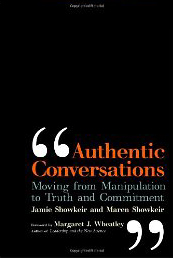COMMUNICATING? VALUABLE. CONVERSING? PRICELESS.
Our work with changing culture through conversations often leads people to conclude that we are in the business of helping people and organizations communicate better. Well, yes and no.
Sure, communication is the foundation, but it doesn’t tell the whole story. Communication and conversations both are n ecessary, valuable and help us get things done. But from our perspective, viewing communication and conversations as the same thing is like comparing a technical manual to great literature.
ecessary, valuable and help us get things done. But from our perspective, viewing communication and conversations as the same thing is like comparing a technical manual to great literature.
By definition, communication is a transmission. It’s transactive and reactive, a process that skews toward the utilitarian. Two-way communication is typical: I deliver information to you, and you react and respond. But delivery/response is not imperative in communication: I can deliver a message to you without wanting or needing a response. And I can receive a message without feeling the need to reply. We can communicate one-to-one, or one person can deliver a message to the masses
Communication is a transaction that says: “Here is what you need to know. This is what I want you to hear.” That’s why a singular focus on “better communication” in a relationship or in an organization misses the mark, in our view.
Conversation, according to Merriam Webster is an oral exchange of “sentiments, observations, opinions and ideas.” And we think it is something much more. Conversations extend an invitation: “Come closer. Let’s engage each other, and talk about things that are meaningful to us.”
Conversations name things and create reality. If we see our boss as efficient, focused and powerful, that is our reality, even as our colleague considers the same person to be distant, a control freak and manipulative. I like rainy days — you think sunny skies are perfect weather.
Through conversations, we reveal what we see and the meaning we make of it. I love the rain because I grew up in the desert, and a rainy day was rare and special. You're from Seattle, and a sunny day always lifts your spirits. Conversations draw back the drapes and let others see through the window of our experience. We invite each other to see what we see.
Our conversations have the ability to sustain our beliefs — and have the power to change them.
Authentic conversations turn it up a notch. When we engage each other authentically and with good will, our conversations become richer and deeper. They build trust, and create relationships we can believe in. Being authentic requires that we treat each other’s life experiences and points of view as a fundamental reality, and let go of the need to convince others that only one reality exists. We honor each other by telling the truth as we know it, always with empathy and compassion. We agree to honor our differences even as we look for ways to find common ground.
Are conversations a form of communication? Of course they are. Like the technical manual, communication is a useful tool for giving and getting information. But an authentic conversations, like great literature, informs our minds and feeds our souls.


 maren
maren